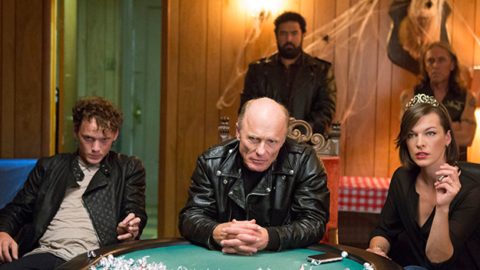NYFF Interview: Michael Almereyda
After a long stretch of making essay films, documentaries, and shorts, writer-director Michael Almereyda has recently made a welcome return to feature filmmaking with the Shakespeare adaptation Cymbeline and Experimenter, a biopic of social psychologist Stanley Milgram. Milgram, played here by Peter Sarsgaard, is best remembered as the man behind the “obedience to authority” experiments conducted at Yale in the early Sixties, in which subjects were instructed to administer increasingly powerful electric shocks to a stranger seated in a neighboring room. While the ramifications of the experiment’s results are dispiriting—65 percent of participants triggered the maximum voltage, despite hearing the stranger’s cries of pain—Almereyda has made a film that addresses big ideas with a mischievous tone and zippy pace. Successfully balancing formal playfulness and documentary rigor, Experimenter allows Stanley Milgram to speak directly to the audience, making the case for his ever-controversial experiment and for the many lesser-known studies that followed.
FILM COMMENT spoke to Almereyda last week about Experimenter in advance of its premiere at The New York Film Festival on October 6 and 7. The film opens theatrically on October 16.
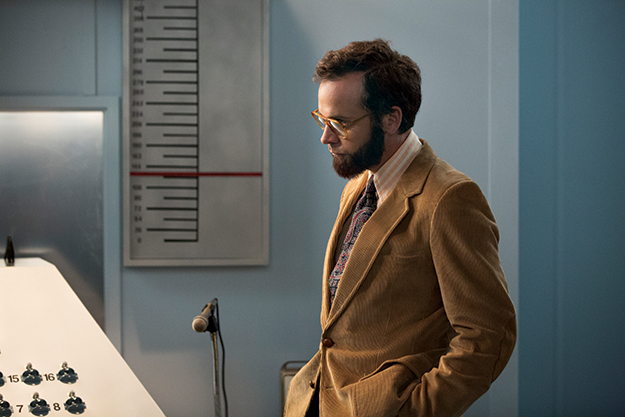
How did you decide to make a film about Stanley Milgram?
I was involved with a young woman who was finishing up at Bard, and she was taking a class that was strictly Milgram, the whole class was on the obedience experiment. And as I was carrying her books—literally—I was occasionally looking at the books, reading the books. Her textbook was Milgram’s Obedience to Authority: An Experimental View, and I became fascinated by it. Transcripts from the experiments read like an episode of Candid Camera written by David Mamet. There was something really engaging, dramatically pressurized, about the situation: a dark humor, and an underlying moral seriousness. And the more I read about Milgram, the more intrigued I became. The idea for the movie took shape from that.
How quickly did you realize that the film would be what to me is a rather unusual hybrid of biopic and documentary?
I’m reluctant to think it’s that extraordinary. It felt straightforward to me given the prototype, which is Milgram’s own filmmaking. He made about six films, which he often narrated in this playful way, talking to the camera like Rod Serling or Alfred Hitchcock in TV shows of that period. That felt organic to the process, that he could tell his own story. He was articulate and self-aware and playful. I was just following in his footsteps. So my first, most basic research involved watching his films—which isn’t easy, as the DVDs are only available for a stiff price, for classroom use. I managed to avoid that by joining the NYU library and parking myself there to watch Milgram movies. That was really instructive and became maybe the chief influence on the manner and the style of the movie. Excerpts from these films are collaged into Experimenter in three places—four if you count the glimpse of the real Stanley Milgram during the end credits.
Along with direct address, you have other theatrical devices such as backdrops and rear projection. Did that vocabulary also come from Milgram’s films?
Not precisely. You can use the word “theatrical” but clearly it’s also cinematic. Rear-screen projections are in movies too. There’s something theatrical in Milgram’s work because he was contriving situations, he was staging events, he was studying behavior by inviting people to take on roles—to reflect human nature through an illusionary situation. That of course reflects back on filmmaking as much as it does on theater. In any case, yes, this vocabulary introduces a kind of fluidity and flexibility that’s very useful for describing someone’s life and ideas and career. I’d written other scripts like this that never got made but it felt especially appropriate for a story about a teacher and a filmmaker, someone who was transmitting ideas, who was trying to translate ideas about human nature both by conducting experiments and integrating the results into some kind of theory. If not a theory, at least a series of further questions. He was a man who was always asking questions. So it felt appropriate to make a questioning movie, not a complacent movie—a movie that manages to do and be several things at a time.
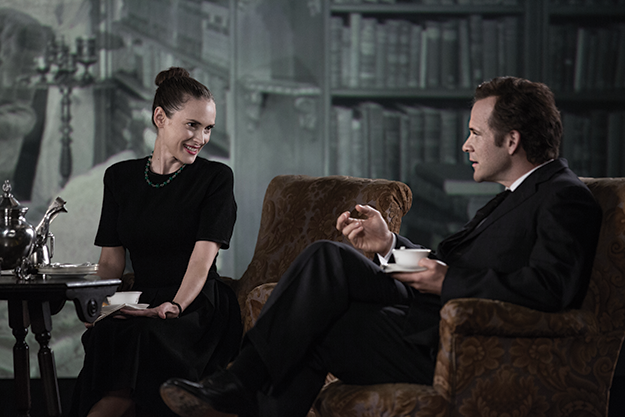
It seems that visually you leave a lot of room for ideas: the film’s backgrounds are quite flat and when you do have a scene with some clutter, such as the Milgrams’ visit to Stanley’s mentor Solomon Asch, you use a backdrop rather than a real set.
Well, you’re parsing it in a more theoretical way than I approached it. I didn’t necessarily divide the backgrounds into categories or think of them in terms of space as insistently as you just did. I think sometimes there’s depth and sometimes it’s just a kind of indication. The backgrounds were meant to flag the idea that some of the kinds of experiences Milgram was having throughout his life were simulacrums. I think that’s true
of anyone’s experience—you dress up to take your wife to your mentor and you’re playacting, in a way. You’re trying to impress the guy and there’s a sense of performance. That’s translated into visual terms with rear-screen projection. It’s also a way to wake up the movie—to recognize that the idea of realism in a movie doesn’t have to be limited. I was thinking about how Milgram’s work invited people to participate in an illusion, and even as you’re aware of the illusion you can get sucked in. I feel there’s still something emotional happening, even in some of those scenes where the backgrounds are transparently phony.
The movie avoids making any direct parallels between the obedience experiment and the present day, but the elephant that follows Milgram down the hallway clearly suggests there is something unspoken. What does that image represent?
I wasn’t keen on illustrating Milgram’s ideas so much as giving them a cinematic shape and feel, or expression. But the elephant is obviously “the elephant in the room” made literal. Though at any given moment what that elephant means, what it represents in the course of the movie, can change. I’m reluctant to define it more—partly because it seems so obvious to me. I had a fun time with the elephant when the movie was shown at the American Film Festival in Deauville, because the French don’t have that expression: “the elephant in the room.” It was completely baffling to them. But they do know the story of the elephant and the blind men, in which each blind man experiences a different elephant because he’s touching a different part of the creature. So I think it can refer to that too. Any attempt to start telling you what the elephant “means” would short-circuit what little ambiguity there is about it. Everyone should recognize their own elephant, measured alongside Milgram’s experiment and its history. Unfortunately, there are many elephants in the room these days, the inadmissible huge thing that we don’t know how to deal with or confront or get out of the room. I hope it’s kind of clear that Milgram’s work is very relevant to the moment, almost painfully relevant, but I don’t need to editorialize about that.
Do you think we live in a particularly obedient age?
No. But I think that the implications of the experiment suggest that human nature yields to many kinds of authority, and this isn’t a purely modern condition—it’s not just obedience, it’s a kind of mass complacency, it’s a kind of—I think he called it “a flaw in social thinking,” whereby you are able to put your conscience on a shelf. You can recognize that you have a conscience but you park it while you’re busy dealing with your job or the emergency of a particular situation or the imagined emergency of it. I think of Milgram all the time when dealing with almost anyone who’s behind a counter or wearing a badge. It doesn’t have to be a malevolent authority, but you just recognize how people shut themselves off and enter what Milgram called “the agentic state.” It’s convenient for people to do that. It’s not necessarily compliance but a suspension of moral values, a kind of sleepwalk. And it does spread into politics, it can lead to genocide—institutionalized genocide. Again, I don’t want to pretend to speak from a moral high ground, but we live in a time where, within many cultures, terrible things keep happening. It’s a deep issue, beyond this little movie. Not many people have asked me to even address it, but here we are.
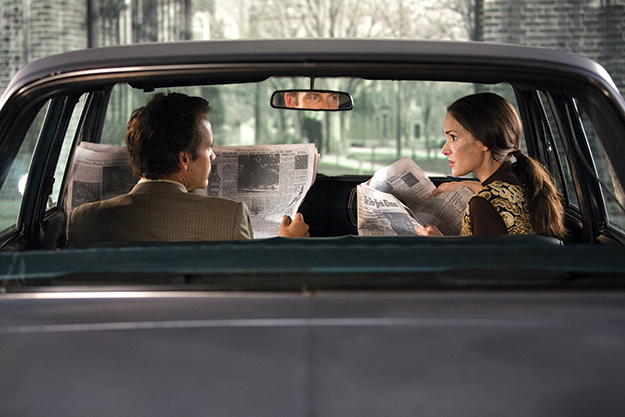
As the movie shows, the obedience experiment had a tumultuous reception throughout Milgram’s life. What is Milgram’s standing today?
Well, I’m not a social scientist but I have been mingling with a lot of people who knew Milgram and believe in him and defend him. They sometimes have a defensive crouch because he’s still withstanding attacks. There was a recent book by a woman who set out to dismantle the obedience experiment through an incredible immersion into the archives. She tracked down what surviving participants in the experiment she could find and she wrote what I regard as a muddled book, a falsely moralistic book, trying to debunk and discredit a famous experiment. I’m reluctant to start swinging at her—the point is that to this day there are people who consider Milgram a manipulative monster. But I find that when I read about him and talk to people who knew him, I recognize more compassion, more intelligence, more deep curiosity about human nature than in any of his critics. To answer your question, he’s still a controversial figure.
How did Peter Sarsgaard approach playing Stanley Milgram?
I sent him a lot of video links—Milgram was on film quite a bit—and he read a good deal of Milgram’s writing, and we visited Sasha, Milgram’s wife, together. But Peter charmingly chose as one primary index an unpublished self-portrait that Milgram made, drawn on yellow lined paper. He’s wearing glasses in the drawing and you don’t see his eyes. Peter seized on that as something veiled, ambiguous or ambivalent about him. I think Peter’s often good at conveying that anyhow, and it came in handy here. There’s an element of charm matched by an element of disengagement, of detachment. Peter recognized Milgram as someone who was alert to other people, studying other people, so sometimes he’s at a remove. That doesn’t mean he was cold, because he was a playful man and devoted to his family. But Peter picked up on that habit of observation.
Something I admire about your career is that while making your own work, you’ve maintained a strong and visible relationship with the work of other artists and thinkers, whether it’s through editing a collection of Mayakovsky’s writings or making a documentary about William Eggleston or now this film about Milgram. What drives you to make work about these other thinkers and artists?
That’s such a good question I don’t even know how to answer it. You’re one of the only people who’s noticed that. I imagine, as readers and viewers, we feel we’re having a conversation with people whose work you like, and if you’re a filmmaker there’s an element of luck—or making a book can be like this too—a lucky situation whereby you can get closer to someone you care about, whose work has mattered to you, making it possible for this conversation to go deeper, and to be shared. That’s an exciting thing to participate in and I guess I’ve been drawn to it without thinking about it.
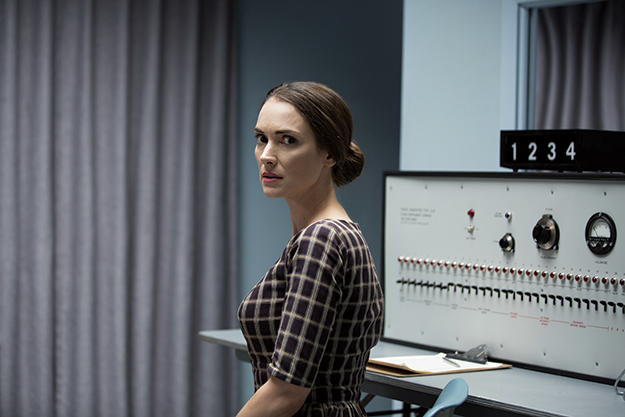
Do you think that your involvement with Milgram’s life and work has had a practical effect on your filmmaking?
I don’t think so. I think there’s a kind of continuity and coherence from one project to the next. For instance, I’ve done a lot of work in short films with rear-screen projections, and though the projections mean something different in those films, the approach became part of a vocabulary that seemed appropriate for this film. Maybe it’s relevant to say that I’ve written a lot of biopics. I do consider this a biopic, I don’t think there’s anything shameful about that genre. I want to do more because I’m excited about the way history, the official version of stories, can converge with a more intimate, personal and subjective view. It’s been fun to recognize how the received idea of Milgram, which in some ways is blunt and generalized, can be the starting point for something more detailed and subtle and far-reaching. I’ve had uneven luck getting my movies distributed, but people seem to connect to this one a little bit more and to think about their own lives in a more direct way. That’s gratifying. It’s a big reason to be making movies.
Now I can’t resist asking what some of your favorite biopics are.
I like the biopics that are more focused. I think most of us do. The ones that don’t have the life-and-death arc. Some of my favorites are Young Mister Lincoln (Ford), Andrei Rublev (Tarkovsky), Wittgenstein (Jarman), An Angel at My Table (Campion), The Elephant Man (Lynch), Blaise Pascal (Rossellini), The Enigma of Kaspar Hauser (Herzog), Raging Bull (Scorsese), Casanova (Fellini), Stavisky (Resnais), and Van Gogh (Pialat).
Was it clear to you from the beginning that you wouldn’t make the movie just about the obedience experiments, for instance, and that you would include Milgram’s later experiments?
Absolutely. Because one of the unfortunate generalizations about Milgram is that he did just one thing. People tend not to know how deeply curious and inventive and prolific he was. The obedience experiments were done when he was 28; he didn’t live long, but he lived long enough to do a great deal of work that has real vitality and interest. The six degrees of separation work is famous in its way, but I think about a lot of the other experiments. They have a point, they have a profundity. It was important to show the scope of his thinking. He was interested in barriers, conventions, role-playing. He was interested in the underside of human nature but he was also engaged in showing more hopeful aspects of it. There’s an element of creativity and courage I didn’t want to leave out of the picture.
In one scene, Milgram visits the set of a TV film based on his experiment and discusses his work with William Shatner and Ossie Davis, which seems like it could be a silly situation but yields a substantial conversation. Was this based in fact or did you imagine it?
It’s about the only thing in the movie that’s truly made up. Everything else I can say was researched and in some ways grafted from an official record, a text or eyewitness account. This is the one invention. There was a movie made from Milgram’s work starring William Shatner and Ossie Davis and it was written by George Bellak whose speech to Milgram actually comes nearly word for word from a letter that’s in the Yale archive. So I didn’t make him up, and I didn’t make up the terrible movie The Tenth Level, but I invented Milgram’s visit to the set. He was actually pretty upset about the movie, he was alienated, he didn’t visit, but I imagined what would have happened if he had. The story Ossie Davis tells comes from his autobiography. Davis was an amazing guy. A great actor who couldn’t get good roles because he was a black man. He gave the eulogy at Malcolm X’s funeral, he was an activist, he was a man of courage and real stature, but his acting career, in the 1970s, was limited. And Shatner’s story about the first interracial kiss is part of TV history. So the scene felt like a reasonable confluence of things—the one patch where I am editorializing, illustrating another aspect of the obedience experiments, as it can apply to racism and race relations. There’s an element of goofiness just to have Shatner, Ossie Davis, and Stanley Milgram occupying the same frame, but it felt meaningful to play out that particular discussion.



